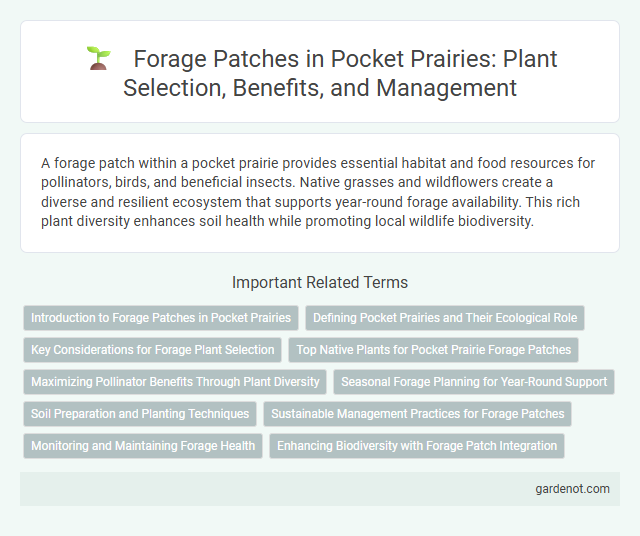A forage patch within a pocket prairie provides essential habitat and food resources for pollinators, birds, and beneficial insects. Native grasses and wildflowers create a diverse and resilient ecosystem that supports year-round forage availability. This rich plant diversity enhances soil health while promoting local wildlife biodiversity.
Introduction to Forage Patches in Pocket Prairies
Forage patches in pocket prairies provide essential habitats that support pollinators and beneficial insects by offering a diverse range of native flowering plants. These patches enhance soil health, improve biodiversity, and promote ecosystem resilience within urban landscapes. Incorporating forage patches into pocket prairies optimizes habitat connectivity and sustains local wildlife populations.
Defining Pocket Prairies and Their Ecological Role
Pocket prairies are small, strategically designed patches of native grasses and wildflowers that restore natural habitats within urban landscapes. These miniature ecosystems support pollinators, enhance soil health, and contribute to biodiversity by providing essential forage for bees, butterflies, and other wildlife. Their ecological role extends to improving air quality, managing stormwater, and fostering resilience against environmental stressors in city environments.
Key Considerations for Forage Plant Selection
Selecting forage plants for a pocket prairie requires evaluating soil type, moisture levels, and sunlight availability to ensure optimal growth and nutrient uptake. Native grasses and legumes are preferred for their adaptability and ability to support local pollinators and wildlife. Consider drought tolerance and seasonal growth patterns to maximize forage quality and availability throughout the year.
Top Native Plants for Pocket Prairie Forage Patches
Top native plants for pocket prairie forage patches include big bluestem (Andropogon gerardii), switchgrass (Panicum virgatum), and Indian grass (Sorghastrum nutans), which provide essential habitat and high-quality forage. Wildflowers like purple coneflower (Echinacea purpurea), black-eyed Susan (Rudbeckia hirta), and goldenrod (Solidago spp.) support pollinators and increase biodiversity. Incorporating nitrogen-fixing legumes such as Illinois bundleflower (Desmanthus illinoensis) enhances soil fertility and forage nutritional value.
Maximizing Pollinator Benefits Through Plant Diversity
Forage patches in pocket prairies maximize pollinator benefits by incorporating a diverse array of native flowering plants that bloom throughout the growing season, providing continuous nectar and pollen sources. This plant diversity supports a variety of pollinator species, including bees, butterflies, and hummingbirds, enhancing ecosystem resilience and pollination efficiency. Selecting a mix of perennial forbs and grasses tailored to the local climate and soil conditions optimizes habitat quality and sustains pollinator populations year-round.
Seasonal Forage Planning for Year-Round Support
A forage patch in a pocket prairie enhances biodiversity by providing a variety of grasses, legumes, and forbs that bloom in different seasons, ensuring continuous food sources for pollinators and wildlife. Seasonal forage planning incorporates cool-season and warm-season species like clover, ryegrass, and switchgrass to maintain nutrient availability throughout the year. Strategic planting schedules optimize growth cycles, supporting soil health and sustainable habitat resilience within small-scale prairies.
Soil Preparation and Planting Techniques
Effective soil preparation for a pocket prairie forage patch involves loosening the soil through minimal tilling to preserve existing beneficial microorganisms and organic matter. Select native perennial grasses and legumes suited to the local climate, planting seeds at the recommended depth and spacing to ensure optimal germination and growth. Applying a light mulch or using soil covers can help retain moisture, reduce erosion, and suppress weeds, promoting a healthy forage stand.
Sustainable Management Practices for Forage Patches
Sustainable management practices for forage patches prioritize soil health by minimizing disturbance and promoting biodiversity through diverse plant species selection. Implementing rotational grazing controls livestock impact, reducing overgrazing, and enhancing plant recovery, which improves forage quality and yield. Integrated pest management and organic fertilization support ecological balance, ensuring long-term productivity and habitat preservation within pocket prairie systems.
Monitoring and Maintaining Forage Health
Monitoring forage patches involves regular assessment of plant diversity, biomass, and soil health indicators such as moisture levels and nutrient content. Maintaining forage health requires adaptive management practices including targeted grazing, weed control, and reseeding native species to promote resilience and productivity. Implementing remote sensing technologies and soil testing protocols enhances early detection of stress factors and informs timely interventions for optimal forage patch sustainability.
Enhancing Biodiversity with Forage Patch Integration
Forage patch integration in pocket prairies significantly enhances biodiversity by creating diverse habitats that support pollinators, small mammals, and beneficial insects. These patches increase plant species richness and structural complexity, promoting ecological resilience and improving nutrient cycling. Incorporating forage patches also boosts forage availability for wildlife, contributing to sustainable ecosystem balance and improved soil health.
Forage patch Infographic

 gardenot.com
gardenot.com